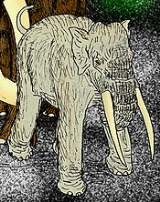
Elephas namadicus
Encyclopedia
Elephas namadicus was a species of 7 feet (2.1 m) prehistoric elephant that ranged throughout Pleistocene
Asia
, from India
(where it was first discovered) to Japan
, where the indigenous Neolithic
cultures hunted that particular subspecies for food. It is a descendant of the Straight-Tusked Elephant.
Some authorities regard it to be a subspecies
of E. antiquus, the Straight-Tusked Elephant, due to extreme similarities of the tusks.
Pleistocene
The Pleistocene is the epoch from 2,588,000 to 11,700 years BP that spans the world's recent period of repeated glaciations. The name pleistocene is derived from the Greek and ....
Asia
Asia
Asia is the world's largest and most populous continent, located primarily in the eastern and northern hemispheres. It covers 8.7% of the Earth's total surface area and with approximately 3.879 billion people, it hosts 60% of the world's current human population...
, from India
India
India , officially the Republic of India , is a country in South Asia. It is the seventh-largest country by geographical area, the second-most populous country with over 1.2 billion people, and the most populous democracy in the world...
(where it was first discovered) to Japan
Japan
Japan is an island nation in East Asia. Located in the Pacific Ocean, it lies to the east of the Sea of Japan, China, North Korea, South Korea and Russia, stretching from the Sea of Okhotsk in the north to the East China Sea and Taiwan in the south...
, where the indigenous Neolithic
Neolithic
The Neolithic Age, Era, or Period, or New Stone Age, was a period in the development of human technology, beginning about 9500 BC in some parts of the Middle East, and later in other parts of the world. It is traditionally considered as the last part of the Stone Age...
cultures hunted that particular subspecies for food. It is a descendant of the Straight-Tusked Elephant.
Some authorities regard it to be a subspecies
Subspecies
Subspecies in biological classification, is either a taxonomic rank subordinate to species, ora taxonomic unit in that rank . A subspecies cannot be recognized in isolation: a species will either be recognized as having no subspecies at all or two or more, never just one...
of E. antiquus, the Straight-Tusked Elephant, due to extreme similarities of the tusks.

